Climbing Pitons Early Evolution--part 1a--Origin of the term "piton", and Marmolada
Mechanical Advantage #8a
Buy the books here:
Volume 1: (mostly) European Tools and Techniques to the 1930s
Volume 2: (mostly) North American Climbing Tools and Techniques to the 1950s
…continuing from http://bigwalls.substack.com


How did the early mountain climbers go from using a simple wrought iron spike in 1893 to a the first “modern” piton, designed by Hans Fiechtl, by 1920?
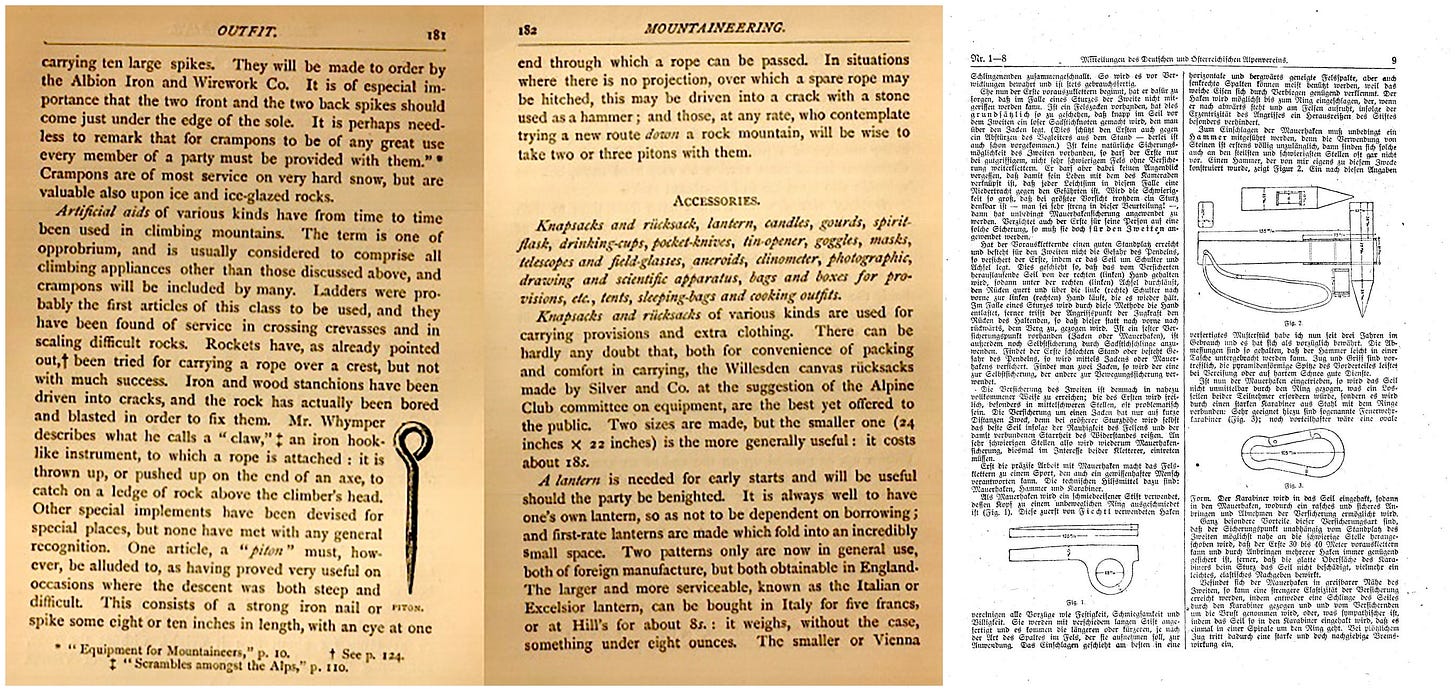
To uncover the mysteries of piton design evolution in this early period, it’s helpful to consider the broader aspects of development at the time. But first, what’s in a name?
Origin of term “Piton”
It is interesting, perhaps ironic, that in 1893 Claude Wilson coined the “piton” in the “All England Series—Mountaineering”, one of the first climbing instructional books in English, a “practical guide for would-be climbers”. Claude was a self-taught doctor from south of London and a distinguished British alpinist who climbed hundreds of the most difficult summits in the western Alps, including the first guideless ascent of the Grepon at age 22 (1892). In the Alpine Journals of his era, the British generally referred to such devices—often disparagingly—as “iron stanchions” because that is exactly what they were in those early days of mountaineering: sections of wrought iron bars made for other purposes, hammered into cracks with a handy nearby rock, and only acceptable as a rappel anchor as a fair means tool in Britain and the Western Alps at the time.
In the French mountaineering journals to 1904, the word “piton” occurs frequently, but only in reference to a steep spire of rock; never as a metal stanchion. The Club Alpin Français 1883 Bulletin Mensuel refers to the anchors on the first ascent of La Géant as “des coins ou pointes d'acier” (wedges or spikes of iron). The French Alpine Journal, La Montagne, first refers to a piton as metal hardware in 1918, and generally specifying a “piton de fer” (iron spike). In the 1916 report on the North Wall of Mont Aiguille, “Le clou” (nail) appears as a 20 cm long metal anchor. Isère’s North Wall was first climbed in 1895; the 1916 climbers removed le clou and proudly reported they did not use it for ascent (“sans l'aide”). It is one of the earlier references to a mechanical tool used for assistance on many ascents and descents of the era, yet generally ignored in the early French mountaineering literature.
In France, pitons gained greater respect and acceptance in the 1929 La Montagne when the great mountain guide Armand Charlet admitted, “…soon we are at the chimney with the iron piton (piton de fer). This piton which until now I have always disdained, I am very happy to use today.” At the moment, he was climbing in a storm at 3500m through a loose and icy chimney while an avalanche of debris was falling onto him, simul-climbing with his partner on the first winter ascent of the Dru.
Footnote: Miriam O’Brien in “Give Me The Hills” (1956) notes, in Chamonix in 1925 “pitons were not yet used, either as an aid to climbing or for assurance. Carabiners were absolutely unknown. By 1926, however, (Alfred) Couttet was using pitons, and using them skilfully.”

The British were especially reluctant to publish—or admit use—any reference to pitons as a developing mountaineering tool in the early days of climbing. Even with the amazing routes in the Alps going up in the 30’s with the aid of pitons by the continental pioneers, A. Cox read before the British Alpine Club in 1941, “The piton, indeed, is in rather a different category, for it is never used, fortunately, as a mere convenience.· Undoubtedly it possesses a power for evil, and it is healthy that it should be viewed with suspicion.” Paul Pritchard recently remarked to me, “avoiding pitons helped Britain push bold free climbing” and it’s true. Then we chatted about the British big wall pioneers of the 50’s and 60’s who then led the world in technical remote big wall climbs, to be covered in later chapters.
In Italian, “chiodi da roccia” (rock nails) is the name for pitons, but the word “piton” in Italian can be translated to English as “snape”, which is a verb meaning to bevel the end of a timber. As early rock anchors for climbing were often wood wedges in addition to iron stanchions, perhaps the Italian word for piton is the origin of Claude Wilson’s reference. The word “piton” does appear in a 1895 French medical journal as a small peg hammered into bone in a surgical procedure; so it might be that Dr. Wilson borrowed the term from the French medical profession (source: Gallica.fr).
Regardless of how the English/French name of “piton” came about, the advancement of pitons was led primarily in the Tyrol and the Dolomites, where our story will continue.
Pitons were originally used in mountaineering as anchor to attach ropes for descent, then as an occasional hand or foothold, then progressing to protection for the roped climber a few moves past the piton. The method of protection advanced to a high art form in the Elbe by 1905 by Oscar Schuster and others (more details on the tools and techniques in the Elbsandsteingebirge to come later).
Marmolata, the Queen of the Dolomites
The potential of pitons was soon realised as the key to climbing the largest inspiring expanses of vertical rock in the Eastern Alps. The new century was kicked off with Beatrice Tomasson’s first ascent of the South Wall of Marmolata in 1901, the largest big wall ever climbed at the time, over 600m/2000 feet. Beatrice was a talented athlete and climber, who organised the first ascent with the Bortolo Zagonel and Michele Bettega. The wall had seen several attempts by 1901, and several mountain guides had made solo reconnaissances. In modern big wall parlance, it was a “prize”: a clear, definable next-step in big wall climbing due to its size, altitude, and prominent location in the mountain landscape.
The first ascent team used four pitons in key sections for their ascent (although the ways and means of the ascent were debated for the next few decades), and climbed in a long day. A route description was never presented, so subsequent climbers had to figure the route out for themselves. The second ascent in 1902 by the German mountaineering brothers Georg and Kurt Leuchs involved three days of initial reconnaissance, then two days on the wall in frosty conditions with a bivouac (“Biwak” auf Deutsch—note that the Leuchs team climbed a variant direct finish on the final headwall). Guido Rey climbed the route with Tita Piaz in 1910 and poetically described his adventure in “Alpinismo Acrobatico”, by which time the route had had about 20 ascents and considered by Rey as the “most difficult in the whole chain of the Alps.” Today, the route involves 27 pitches of climbing and has over 50 fixed pitons. Despite the route’s significant advance in big wall commitment, the ascent was largely forgotten after WWI, when the difficulty of the climb had been eclipsed by a new generation of piton-assisted ascents in the greater Alps and in the USA (footnote).
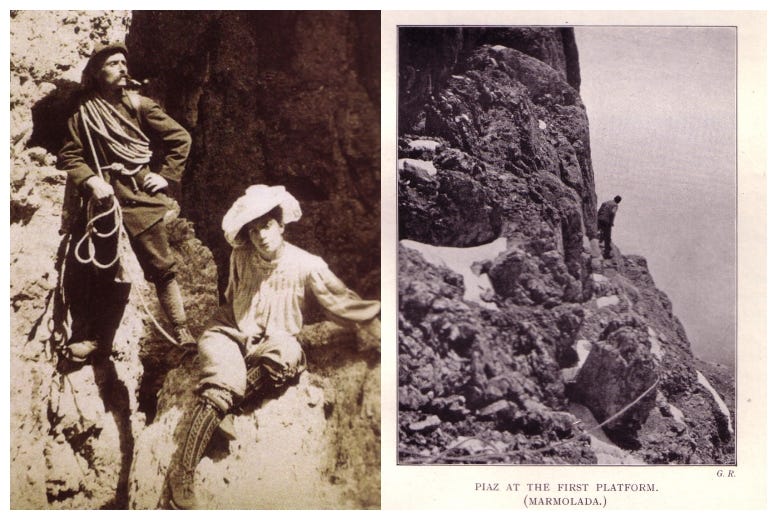
Footnote: it’s remarkable the original route up the south wall of Marmolata/Marmolada is not mentioned in many timelines of climbing, such as A History of Mountain Climbing, published by Arthaud in 1996, and many other histories—it is as though the first ascent of the NW Face of Half Dome, a wall similar in height, was historically ignored as a significant milestone in climbing. One of her early climbing partners, E.Strutt, reports in the 1942 Alpine Journal: “On many of these expeditions I was accompanied by Miss Beatrice Tomasson (Mrs. Mackenzie), an accomplished horsewoman and climber. In later years she achieved for the first time the two best snow and rock expeditions left in Tyrol : the E. (Sulden) face of Monte Zebrù and the S. face of Marmolata.” Doug Scott provides a brief mention in his Big Wall Climbing (1974), noting that the next new route on Marmolada was not made until 1929, but this pioneering climb must be one of the most under-celebrated moments in big wall history, until a well-researched paper on Tomasson by Hermann Reisach appears in the AJ in 2001. Anette Köhler and Norber Memmel’s inclusion of “Via Classica” in their Classic Dolomite Climbs (1998) also highlights this milestone route (which is still quite loose in places!).
next: part 1b

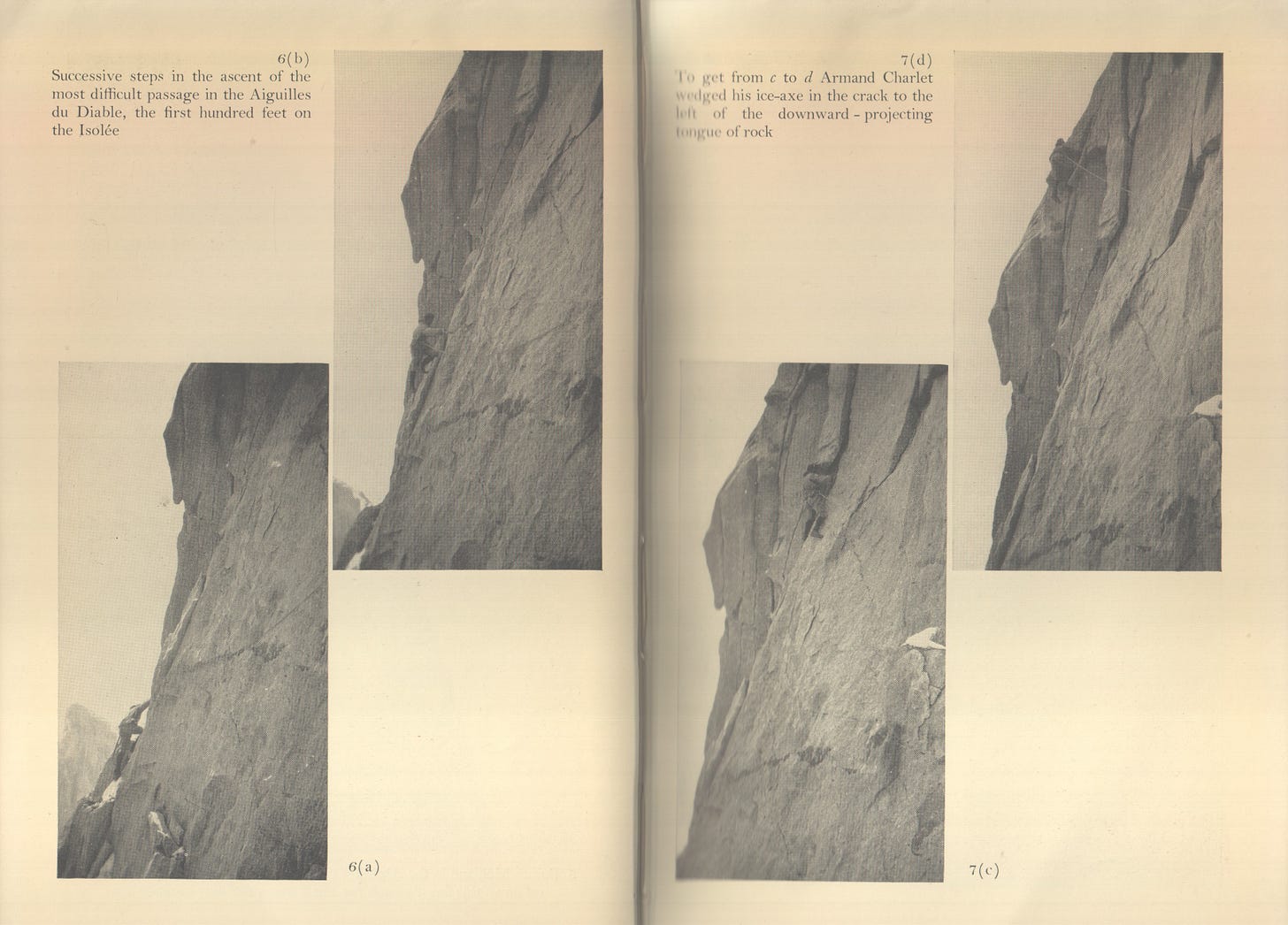
LINKS
In the Beginning: Subtle Means and Engines
The Modern Era of Mountaineering (1786)
American Trail Builders, 1800's
Rope Technology in the 19th century
Mizzi Langer -- first advertised rock climbing pitons (Mauerhaken)
Climbing Pitons Early Evolution--part 1a
Climbing Pitons Early Evolution--part 1b
Climbing Pitons Early Evolution--part 1c
Climbing Pitons Early Evolution--part 1d
Climbing Pitons Early Evolution-part 1e
Tita Piaz-Alpinisto Acrobatico (Piaz PartA)




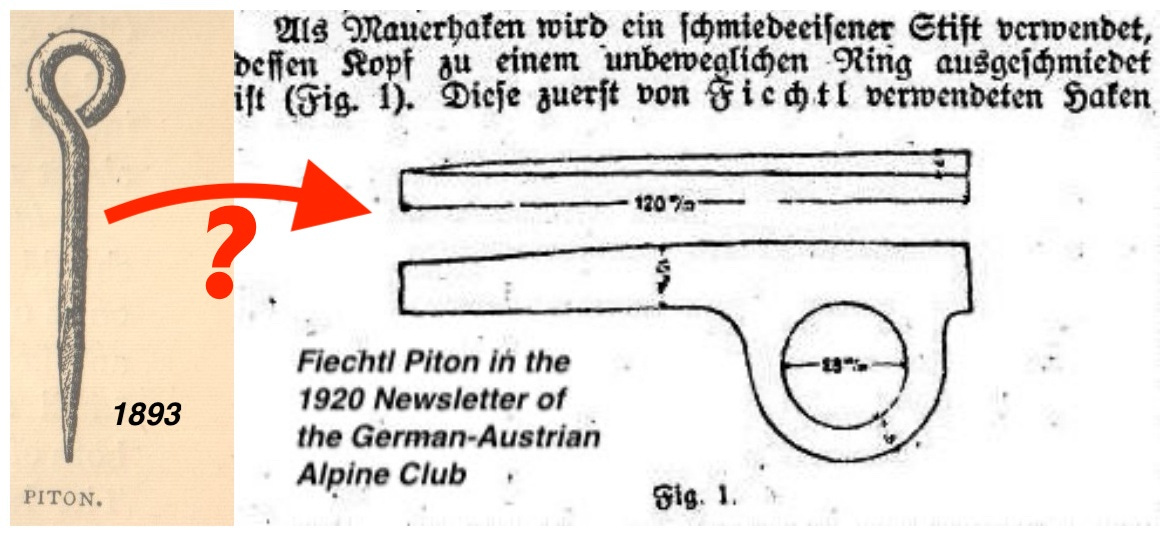


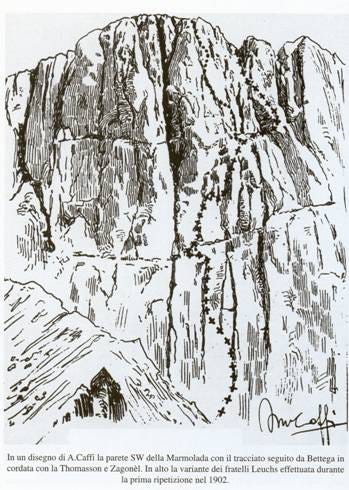
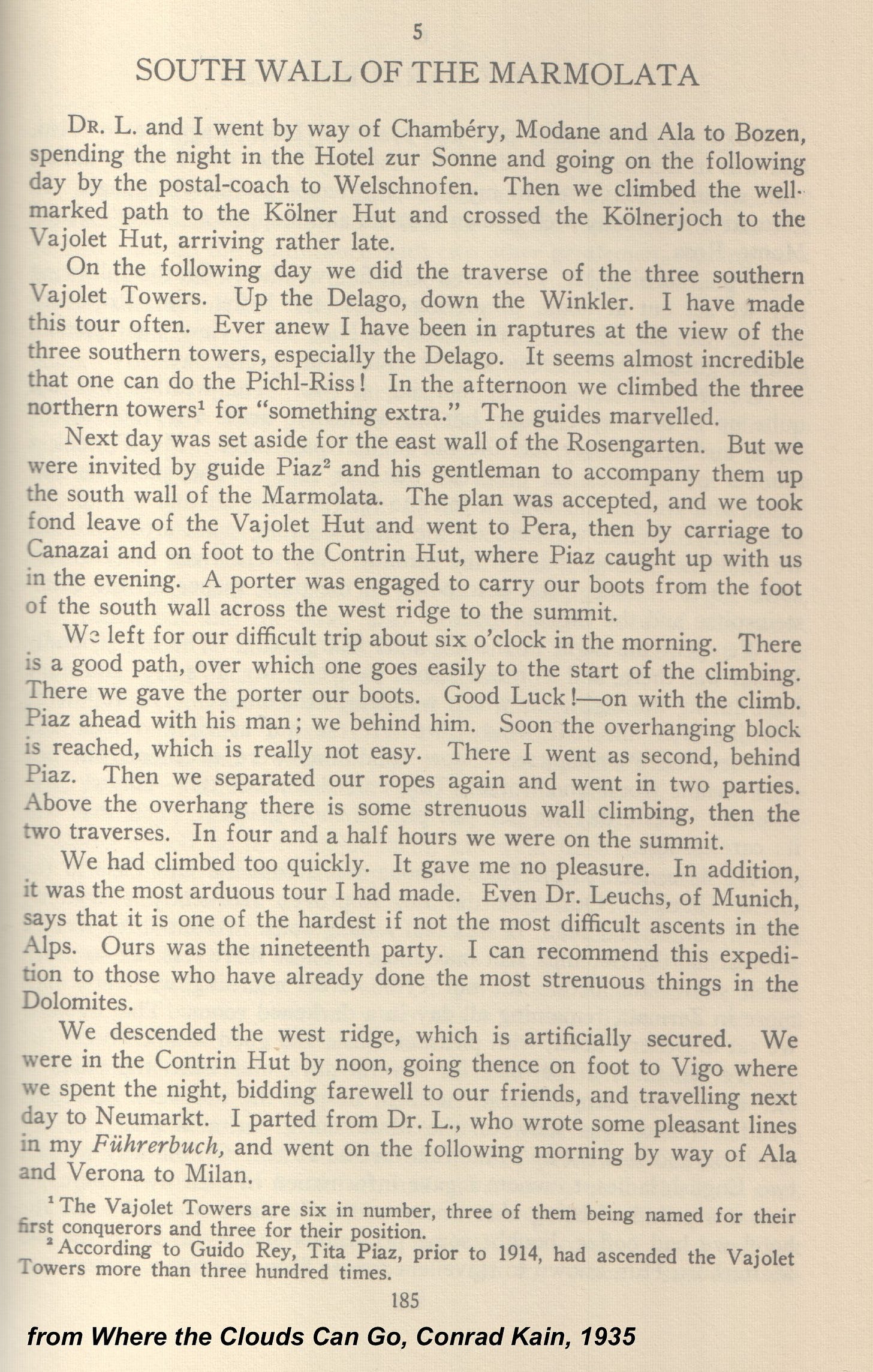

I really enjoyed this John.
The British attitude towards pitons in the 20s and 30s can be gauged by the response to the ascent of Munich Climb [VS / 5.7] in North Wales, pioneered by visiting Bavarians who used three (!) pins. At the time it was said "the hand which could insert a piton into British rock would be capable of drawing a trigger on a fox." (The only sporting way to kill a fox is to have your hounds tear it to pieces...).
apologies, I accidently sent out a draft of this chapter, with a bunch of arcane notes in the second half, so this Climbing Pitons Early Evolution, part 1 will be split into two parts, part 1a and 1b. oops! That is what happens when you try to make a quick edit on the iPad while playing a card game with your kids!